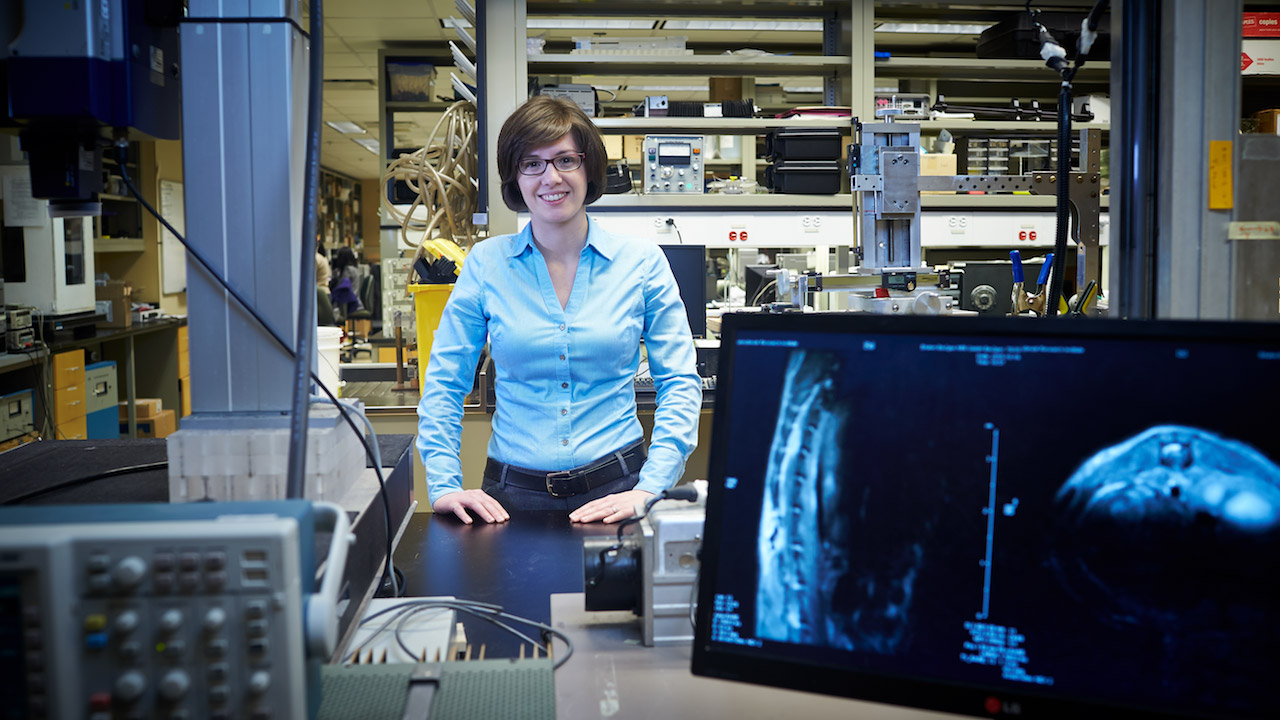A welcome disruption
Dr. Meaghan O’Reilly, a scientist in Physical Sciences at Sunnybrook Research Institute (SRI), led a study that is the first to show that using focused ultrasound to deliver a drug to treat tumours in the spinal cord has a therapeutic effect. The study was conceived by O’Reilly and Dr. Arjun Sahgal, a scientist in Physical Sciences at SRI, and deputy chief of radiation oncology at Sunnybrook’s Odette Cancer Centre. The findings were published in June 2018 in Scientific Reports.
Thanks to advances in treatment, people with cancer are, on the whole, living longer. Yet, even as oncologists achieve better control of the disease, complications can arise. One of them is leptomeningeal (lep-toe-men-in-gee-al) metastasis, where cancer spreads from its original site to the cerebrospinal fluid and membranes covering the brain and spinal cord.
Leptomeningeal tumours, which arise most often from cancers of the breast, lung and gastrointestinal tract, as well as leukemia and lymphoma, can cover large portions of the spinal cord, thus ruling out radiation therapy and surgery. Moreover, drugs are stymied by a biological safeguard called the blood-spinal cord barrier. This barrier protects the central nervous system from toxins in the circulation, but it also blocks therapeutic agents from reaching their target. The lack of treatment options is what prompted Sahgal to reach out to O’Reilly about studying the applicability of focused ultrasound. “There’s a huge care gap for leptomeningeal metastases, particularly in the spinal cord. In the brain, even though it’s palliative and not a great option, you can do whole-brain radiation, but you can’t irradiate the entire spinal cord because of radiation toxicity,” says O’Reilly.
In rats with leptomeningeal tumours arising from a breast cancer subtype, the researchers compared the effects of three approaches: no treatment, administering an antibody called Herceptin and using focused ultrasound to deliver the antibody. This last intervention involves injecting microbubbles into the bloodstream and stimulating them with focused ultrasound to disrupt temporarily the blood-spinal cord barrier. When this happens, the drug can slip past into the cord and reach the tumour.
The size of the tumours changed little in the rats that had no treatment and in those that received the drug alone. Where focused ultrasound was used to deliver the drug, however, tumours shrank considerably—to about one-third of their size, on average.
“There’s been a couple of publications showing that you can deliver stuff to the spinal cord, but this is the first evidence that we can have a positive therapeutic effect, and importantly, in the animals, we didn’t see negative effects. They tolerated the treatment very well,” says O’Reilly.
The results offer a glimmer of hope to those affected by the disease. The prognosis for leptomeningeal disease is poor; the average survival is two to four months and symptoms can be downright dreadful: seizures, double vision, and difficulty thinking, speaking and swallowing. “This work is of critical importance as it shows the potential for penetration of systemic therapy into the leptomeninges, which has not been shown before,” says Sahgal, who co-authored the study. “With further testing there is potential to move this to humans and make a major impact on these patients’ survival given that at present, very little is gained with traditional approaches—including radiotherapy.”
Next, she will conduct larger preclinical studies on leptomeningeal disease to determine whether using focused ultrasound for drug delivery enhances survival. She will also study the effects of focused ultrasound alone, as well as focused ultrasound combined with injection of an anti-cancer agent into the cerebrospinal fluid.
The publication caps a banner year for O’Reilly, who, in addition to having a baby, has secured research funding from the U.S. National Institutes of Health and the Canada Foundation for Innovation. To top it off, she was recognized with an Early Researcher Award from the Ontario Ministry of Research, Innovation and Science. Acknowledging her extraordinarily fruitful year she jokes, “When the money runs out and the publications stop, I have to go back on maternity leave.”
She says she is excited not only about the results of the study, but the promise of focused ultrasound to treat disorders of the central nervous system more generally. “This work has implications for studies looking at other types of tumours, and also branching out into spinal cord injury or neurodegenerative disease. It’s a first in what will hopefully be many investigations in the spinal cord.”
The focused ultrasound research program at Sunnybrook Research Institute is part of the Centre for Research in Image-Guided Therapeutics, which was established by the Canada Foundation for Innovation. O’Reilly’s research was supported by a donation from the Sumar family, the Ontario Ministry of Research, Innovation and Science, and the U.S. National Institutes of Health.
In a nutshell
- Dr. Meaghan O’Reilly led a study that is the first to show that using focused ultrasound to deliver a drug to the spinal cord has a therapeutic effect.
- The researchers used microbubbles stimulated by focused ultrasound to deliver an antibody past the blood-spinal cord barrier, which shrank spinal cord tumours significantly.
- The study was published in Scientific Reports.





